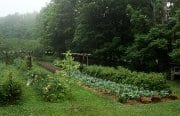by Lauren Chase Rowell
“The finest design for society will not be one worked up by specialists but a design created by the people themselves to fit their needs. Planners and designers are needed, but to help, not to preempt, the democratic work of creating a new society”. –Wm. S. Coperthwaite
Part 1
Conscious Design in the Kitchen
Permaculture, simply put, is the conscious design of everything humans do. Good design is critically needed at this juncture in our human story if we are to succeed as a species, and good design can be done by anyone. In this sense, permaculture is inclusive and its current popularity speaks to everyday people making design decisions and re-skilling themselves to fit their needs and fulfill their wishes. The blend of mindful intention, good old Yankee ingenuity, and common sense that constitute permaculture principles and practices, has made permaculture the main stay of my lifestyle for many years.
My family found Dalton’s Pasture over 25 years ago in a local newspaper advertising the farm as “a handy-man’s special”. The old farm was in tatters, both buildings and land. The roof and sills of the house were gone, a hand pump in the kitchen sink was the only plumbing, and an outhouse was attached to an outside, dilapidated wood shed. Chimneys and fireplaces were worn out and would need to be replaced. Horsehair plaster walls sagged and floorboards, worn through, exposed the sub-flooring beneath. But our eyes, satisfied with the intact fireplace mantles and chair-rail, did not see the lists of expenses and hours of hard labor that continue to haunt us two and a half decades later.
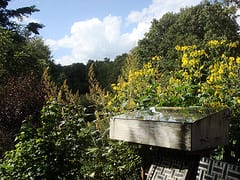
A handmade solar dryer dehydrates herbs, mushrooms, fruits, and vegetables to nutritional perfection and for ''free''.
We saw, with the energetic naïveté only twenty year-olds can muster, a naturally built home still standing after 200 years, nestled among stonewall-lined fields and second growth forest. We had no idea how the town’s school rated or if it was a good neighborhood, and resale value was as far away from our eager dreams as was the reality of a school bus making it over the single-lane, three mile road. Simply put, we did not choose by conventional wisdom. We chose the potential and sense-of-place.
So with two babies, two dogs, and seven prior years of homesteading experience, we chose to put our roots down in a place where the land’s soils, springs, sugar maple trees, and abandoned pastures beckoned to us more loudly than our parents’ disapproval, friends’ concern, and popular and mature rationale. Unable to articulate the magnetism the broken down farm, soils, and land held for us, we began our permaculture adventure not only resurrecting house and gardens, but building excitement, challenge, and meaning into our family’s daily life.
Learning to Find Solutions
We made as many mistakes as we did successful design decisions. Guided by continuous observation and interaction (which is a nice way of saying we learned from our mistakes), we became the designers of every aspect of our lives, from energy efficient natural building techniques, through eating healthy foods, to allocating our slim resources to small, slow, and often subtle, solutions. In this way, we find that staying small and close to home, we make a significant impact in the greater world around us. Using permaculture, we find there is nothing too insignificant or too big in size to redesign into a usable human scale that fit elegantly into the land of our burgeoning farmstead.
It is important to recognize that the ‘conscious part’ of conscious system design requires a mindful presence, a watchful awareness of patterns, and curious observation. The heart of permaculture design radiates out from the dwellers; their goals, needs, sense of beauty, time budget, and capabilities are integrally woven into the natural systems of the land in that very particular place on earth. It is the slow and incremental accumulation of time saved, resources not used, and effectiveness, which brings a core of elegance, creativity, and presence to the inhabitants. Beginning with the self or the internal landscape of the human being, design criteria are born and then melded to the interior and exterior functions of the home and land.
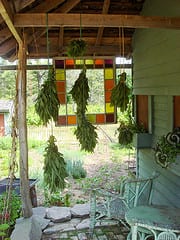
Not all herbs are dried in a solar dryer. Bundles of stinging nettles are hung to dry in a cool, shady space adjacent to where they grew. Dry nettles are used for "tea", broth, and compost tea for garden plants.
Our kitchen design embraces the goal of growing three quarters of our food. A big double sink holds vegetables to be scrubbed and also accommodates the large canner and pressure cooker for preserving food. Floor to ceiling shelves hold the daily array of canning jars, and a large cabinet in a cold corner of the room houses nutritionally delicate nuts, flours, and grains. The sink, stove, refrigerator and gallon sized compost bucket (that to this day gets filled with fresh scraps daily from eating a whole foods diet) are a calculated five steps away from each other. A stack of thirty two plates for feeding a crowd are selected for their ability to take less than twelve inches of headroom in the cabinet.
Designing for Efficiency and Effectiveness
Big southeastern windows fill the space with natural light while looking out upon an enclosed, “zone one” kitchen garden designed for the use of all adjacent kitchen gray water without the need to store it. The contents of each drawer, shelf and cabinet are organized according to how often the items within are needed. We severely restrict the use of potentially toxic plastics by supplanting nondurable goods with rugged, flea market and yard sale finds from yesteryear, when goods produced were made to last. The kitchen is heavily supplied with second hand, high quality, stainless steel pans, utensils, and the fewest appliances required to get the job done. We fed 600 guests in 2011 alone, without once using paper products.
Other rooms in the house are designed with human efficiency and effectiveness in mind. Off of the kitchen, the laundry room has floor to ceilings shelves and ample bins designated to family members so as to never have the need to lug clothing upstairs or to squish it into blind bureau drawers. Dirty clothes are placed in the washer, dried on a handy rack, folded, and placed on shelves. Seasonal clothing is cycled from higher storage shelves to lower, easily accessible ones. We save time, steps, and frustration, and by not using bureaus we free up room square footage and financial resources.
This consciously designed system does beg questions: how many shoes, jackets, hats, and outfits are truly needed by each member of the family? How worn out is each article of clothing before it is passed along? Is there an awareness of the “full life-cycle cost” of the fabrics we choose to wear? What styles and fabrics are more ageless and don’t fall into wasteful planned obsolescence?
Preservation and Storage
One of my favorite spaces in the house is the “root closet”. This closet is on the first floor of the old farmhouse in the living room where it is conveniently accessible and where conditions are favorable for storing food for the long New England winter. The closet is in the corner of the room and features two exterior walls affected by the outside temperature. The original wall voids are 2’’x4’’ construction, and despite the blown-in cellulose insulation, the temperature in the closet plummets to 43 degrees in winter. In permaculture we say, “The problem is the solution!” The result is a perfect food storage room for canned goods such as, honey, maple syrup, jams, juices, jellies, and vegetables.
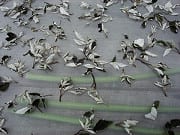
Red raspberry leaves for "tea" are spread out on a fine mesh screen to dry. These leaves are ready for processing.
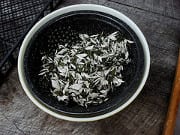
A colander full of dry raspberry leaves is set into a bowl to catch the "tea" as it falls through the holes. Fingertips, in a repetitive circular motion, gently work the leaves into pieces, leaving stems in the colander to discard.
Here I should note that canning has the most embodied energy of all preservation techniques. The food preservation method using the least amount of energy is storing whole foods right from the garden. On the closet floor, where the temperature is the coldest, we stack baskets and wooden boxes full of potatoes, onions, carrots, red and yellow beets, turnip, leeks, garlic and parsnips. The floor to ceiling shelves we designed hold all of the jars, and the upper-most shelves hold a half-dozen varieties of winter squashes, as they benefit from warmer and dryer conditions.
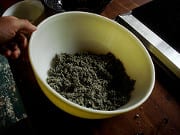
The results after the colander is removed is a bowl of beautifully fragrant red raspberry leaf "tea" ready for tea bags or a tea strainer.
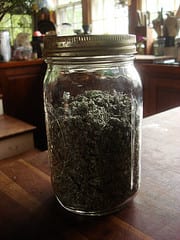
Red raspberry "tea" is then stored in an airtight jar in a dark cabinet out of direct sunlight to protect the delicate flavor and nutrients.
Years back we used to bring buckets of clean sand home to surround carrots, parsnips, beets, cabbages, kohlrabi, celery root, and leeks, keeping them in their required moist conditions. As we learned to be more resourceful with the materials on our property, we stopped using sand and began packing our vegetables in moist maple leaves, which are local and abundant. I recycle old towels and cover the wooden boxes, pressing the folded towel into the edges of the boxes like a cover. The towel breathes and moisture is slowly dispersed to keep the humidity higher in the space, while never water-logging the food beneath. Two to three times a winter, I pour water on the absorbent towels, which act as a sponge between crispy vegetables beneath, and cool, humid air above. This method keeps the vegetables almost perfectly until the first days of spring.
The next least energy intensive methods of storing healthful food on our farmstead are fermentation and solar drying. In what is referred to as lacto-fermentation, certain vegetables are processed in salt, and allowed to ferment in their juices in crocks, jars, and other non-corrosive containers. Cabbage, cauliflower, broccoli, carrots and beans make tasty mixes. In the old days, fermentation was necessary due to lack of refrigeration, but current science and nutrition recognize the health benefits to our digestive systems by adding sauerkraut and American versions of kimchee to our diets.
Solar drying dehydrates all our teas, herbs, mushrooms, fruit leathers, as well as some fruit, berries and vegetables, for “free”. We built the solar dryer from mostly repurposed materials. It holds two 2’x3’ mesh trays, and on a clear sunny day, food is ready to store in clean jars within ten hours.
What Food Gathering Around the Calendar Entails
Food gathering encompasses the entire calendar year. This is done with a conscious effort to use as little non-renewable energy and materials in the mix as possible. Gardens are no-till and rely on timely planting and the use of thick, diverse mulches. As the farm’s soils improve over time, as much emphasis goes into protecting the soil biology and structure as goes into all the steps required in growing plants. Bare soil is quickly covered, whether with mulches or living plants. Compaction is kept to a minimum by utilizing narrow pathways; the constant addition of diverse, on-site organic materials; and leaving the roots of most annual plants to rot in place. These methods allow waste streams, such as grass clippings, coffee grounds, twigs, leaves, intact annual root masses, and hand-pulled weeds, to become resources used in place. These methods also save workers time and energy by designing the garden systems in tightly integrated loops with a steady supply of needed resources close to hand where they will be used.
Conscientiousness of material inputs in growing and gathering food helps us to weigh the necessity of purchases that we can do without. For example, plastic tunnels and row covers for season extension are considered non-renewable, and are not used. This begs the question if eating salad greens in January and February is truly eating in season, and what is the full life-cycle cost of those greens. It may be well worth it in a hundred-foot greenhouse raising mixed greens for local restaurants where net production outweighs materials used, but it is a different matter for a family of five when so much healthy food is already at hand without the use of plastics, which eventually deteriorate, get thrown out, and remind us “there is no such thing as away.” Eating locally and in season sometimes requires a simple no; we can’t have salad or strawberries, or non-season game or fish right now, and will have to wait for it!
Despite the above sustainability conundrums, we like to focus on the abundance of foods we can have around the calendar. In February we tap sugar maples, as well as black and yellow birch (Betula lenta and Betula alleghaniensis, respectively) for their rich wintergreen flavored sap. After the boiling of sap into syrup, early spring beckons the foraging for the first wild greens such as chickweed, chervil, and dandelion, followed by the emerging tips of stinging nettles, burdock root, and cattail stalks.
The previous season’s parsnips, left in the garden all winter to sweeten, are dug as soon as the frost leaves the ground. We also remove the leafy insulation placed around several turnip heads and dwarf kale plants. When exposed to the warming spring light and longer day-length, rapid flushes of emerald leaves emerge from the stems, providing the same deep-cleansing greens to the diet as the foraged plants already mentioned.
As early spring approaches, bi-weekly root “closet” scans are required to check the shrinking bulk of stored food for bad spots on squash and pumpkins, and sprouts on potatoes, onions, and root vegetables. Any vegetable bearing small impairments is culled, prepared, and eaten right away, feeding the spoiled parts to the red wigglers kept in the cellar. Also, at this time any sprouting garlic bulbs are peeled, chopped, and covered with oil in a glass jar. The jar is stored in the refrigerator and is used until the juicy scapes of the garlic planted last fall are ready for fresh eating and an early pesto.
The first warm days can bring on a flush of oyster mushrooms on old maple trees, and fiddle heads along stream banks and floodplains. By this time spinach, peas, lettuce, broad beans, and onions are sown and planted. Herbs quickly become plentiful for food and medicine, like parsley that overwintered but hasn’t gone to seed yet, lovage, chives, and cress. Several kinds of tender, unfolding leaves of common tree species can be eaten on salads, or just nibbled for nutrients. Japanese, red and sugar maples come to mind. Early flowers, too, like violets, tulip petals, apple, and geranium blossoms, can be sought and enjoyed until the full summer on-slaught of fresh food is ready once again for harvest and preservation.
Waste Not, Want Not
I learned early on that it is relatively easy to grow a garden full of food, but much more difficult to consciously design a food system which doesn’t grow an excess which may get wasted. In other words, growing just enough for fresh eating and preservation takes considerable thought and planning. Even though our chickens are close by to help eat any extras, it is a waste of time, energy, and resources to nurture plants from seed to fruition if they are going to bolt, rot, or go unharvested. I can promise myself that I will give extras away to others who could benefit, but experience has taught me that even with the best of intentions, hot weather and busy schedules render vegetables highly perishable. It is better for me to learn to grow just what I need, and to share the bounty through potlucks, dinners, preserves, and gifts while keeping the quality and quantity of goods produced at the highest level possible.

Stainless steel pans simmer black currants for processing into many value-added products. Note the food mill in the background.

After gentle simmering, black currants are hung overnight in bags suspended from the ceiling. The unhurried drippings make juices and jellies with unsurpassed clarity.
Here’s an example of the permaculture premise of “produce no waste.” It ties together the indoor and outdoor relationship of home food production: bushels of black currants were harvested and made into jelly and juice. The remaining fruit left in the jelly bag (after being hung on a beam and dripping over night) was put through a food mill and made into jam on the stovetop and fruit leather in the solar dryer. The dregs of black currant skins, seeds, and stems leftover from the milling were used to dye some simple articles of clothing in beautiful hues of bluish purple for the pure fun and adventure of it. After dying, the refuse was given to the chickens that loved every bite.

Black currant syrup mixed with blueberries top homemade ginger ice cream for a delectable treat for family and friends.
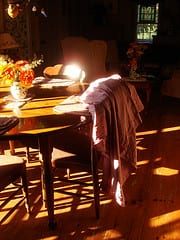
After milling the fruit, the dregs of skins, seeds, and stems are used to dye simple fabrics into beautiful bluish-purple hues.
Though the benefits far exceed the woes, raising our own food is not entirely glamorous. It consumes most of our weekends with the relentless need to scour over the edible landscape to find what is at peak condition for eating or preserving. At times I feel like I live in a choice-less vacuum, constantly “bossed around” by animals needing this or garden crops needing that. At the same time, however, it is also a lifestyle that is peacefully agreeable in a chop wood, carry water kind of way. Being conscious designers in partnership with the natural world, we are able to see progress in our lives as we grow to understand and to be guided by the permaculture principles and ethics.
Part 2 Conscious Design in the Yard and Landscape will appear in the March issue of the Newsletter.
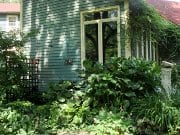
The species composition and placement of plants within this polyculture help to clean the gray water from an outdoor shower while putting the water to good use.

